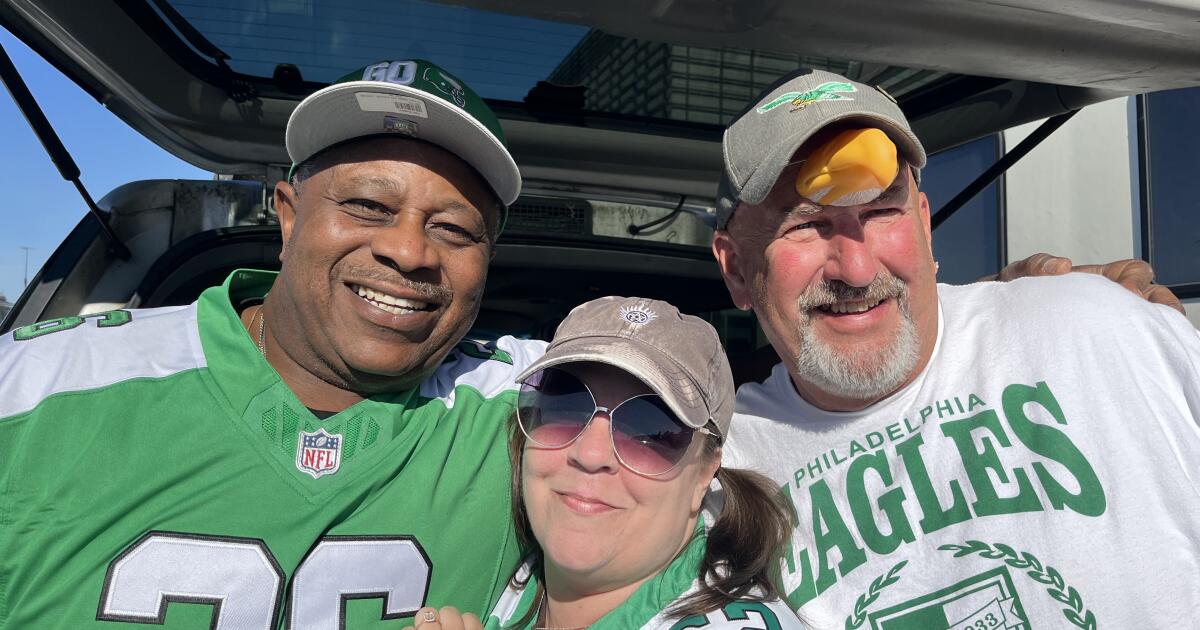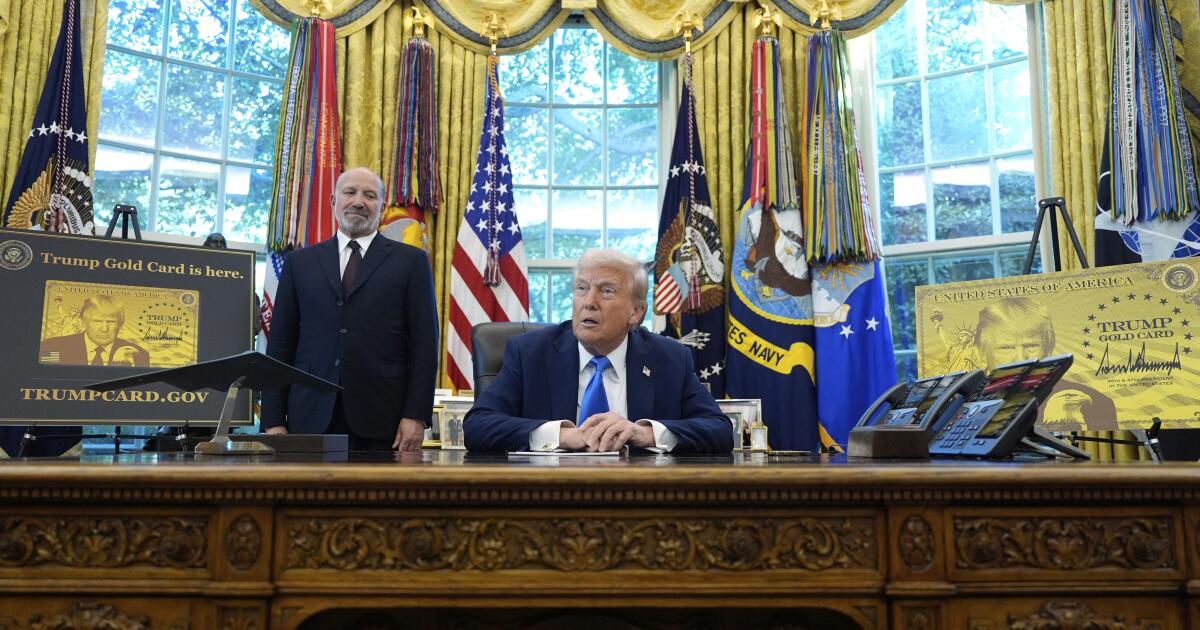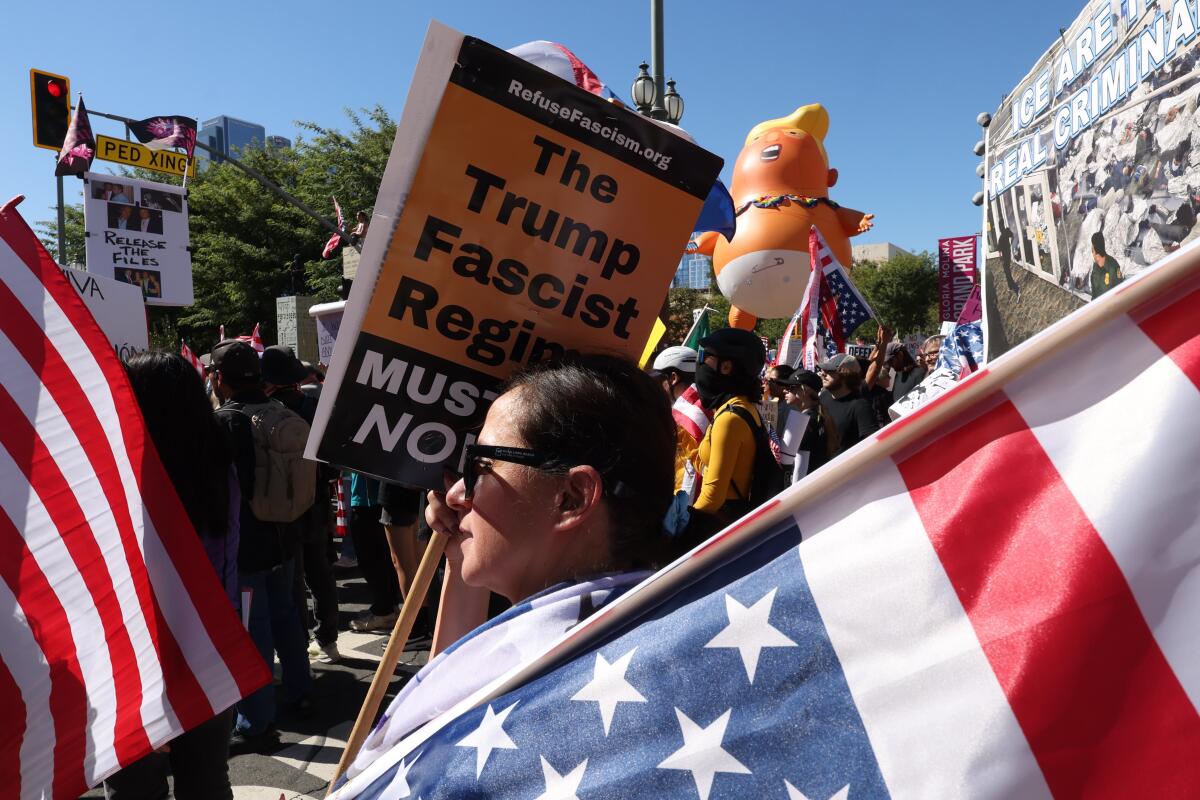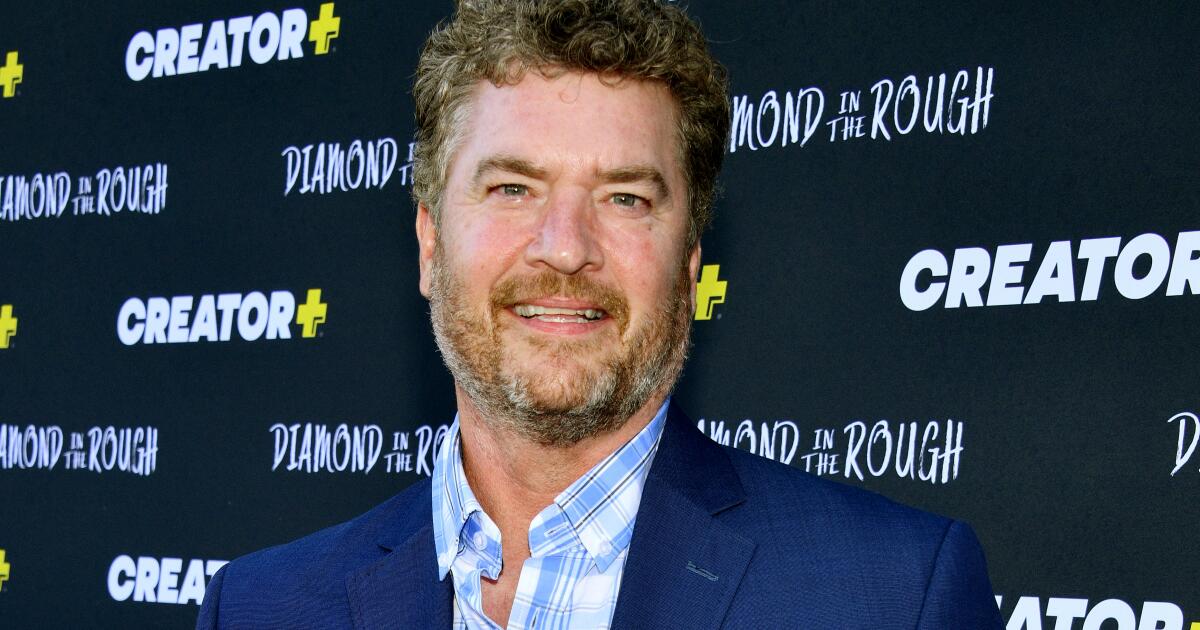Politics
Who needs Trump or Harris? In hotly contested states, it was time for football

PHILADELPHIA and GREEN BAY, WIS. — A bird beak perched on his nose, a Philadelphia Eagles’ fan expressed his disdain for the day’s opponent by dragging a Jacksonville Jaguars helmet on the ground by a leash.
Nearly 1,000 miles northwest, green and yellow Green Bay Packers flags punctured the otherwise dreary, rainy gray skies, as the Wisconsin faithful replaced their trademark cheesehead hats with ponchos and tried to stay dry under pop-up tents before their contest with the Detroit Lions.
On Sunday, two days before the election, in two of the nation’s most closely divided states that will determine control of the White House, football took center stage for fans who also happen to be voters.
Over cheesesteaks and Yuengling beer in Philadelphia and an inordinate variety of sausages and Miller Lite cans in Green Bay, fans were trying to put their election anxiety on hold for a few hours of tailgating and four quarters of football.
Watching the game in person meant they could escape the nonstop attack ads that have blanketed battleground states for months with increasing intensity ahead of election day on Tuesday.
“I stopped watching TV, and it’s almost impossible to listen to the radio, because you want to try to try to get a moment of peace, and you just can’t get it,” said Tim Ellsworth, 63, who lives in a suburb of Green Bay and was tailgating across from Lambeau Field.
The retiree, who previously ran paper mills, is a supporter of former President Trump, but he’s sick of the politicking by politicians on both sides of the aisle.
“It’s just who can lie more? You can’t believe any of it from either side. It’s just pathetic on either side,” he said.
A friend and fellow Packers-Trump fan whom he had been tailgating with since 10 a.m. unsteadily waved a bottle of beer and showed off rounds of spent shotgun shells to a reporter before asking Ellsworth what Trump had lied about.
“It’s all the way through,” Ellsworth replied. “All the way. At the Senate level, down to the local, state levels. They’re lying. So I just look forward to Tuesday.”
Dave Schofield, who wore the Eagle beak on his nose outside Lincoln Financial Field in Philadelphia, said he is anxious that Trump is blowing the election because “he can’t keep his mouth shut.”
“Some of the things he says, it’s all right to say it at a bar with your buddies, but you don’t say that stuff out loud,” said Schofield, a 63-year-old chemical salesman.
But Schofield and his friends weren’t stewing or scanning the latest polling averages on Sunday.
“Everybody’s worried more about the game today,” said his friend Everett Terry, a 65-year-old police officer who posted a “Trump Safety/Kamala Crime” placard on his truck. On Monday, he said, they can get wound up about politics again, then wait like everyone else for Tuesday’s results.
Despite the country’s political polarization, many people in these tailgate groups weren’t even sure who their football friends were supporting.
Mike Warren, a 67-year-old human resources worker from Philadelphia, supports Vice President Kamala Harris.
(Noah Bierman / Los Angeles times)
“We’re here to talk about the Eagles,” said Mike Warren, a 67–year old supporter of Vice President Kamala Harris in the same tailgate group as Schofield and Terry.
Warren was more eager to show off the green illustrations on the van he bought this year with his brother, with images of LeSean McCoy and other Eagles legends making spectacular catches.
But underneath, Warren is also scared.
Trump “will go against whatever the rules say that he should do,” said Warren, who works in human resources. “The majority says one thing, he disagrees. He finds a way to get around it. That’s what scares me.”
Steve Rostloch, a 41-year-old carpet installer from Mequon near Milwaukee, is a Harris supporter and said he expected to her to win.
“She’s a woman. Women always win,” he said. “I ain’t voting for that idiot.”
But if Eagle and Packers fans shared anything, it’s the recognition that Trump and Harris remain neck and neck.
“I’m hoping Trump wins, but I don’t know. This is tough to say. I mean, it seems like it’s very close in so many places,” Cyle Wanek, 42, said outside Lambeau Field.

Cyle Wanek, left, and his family attend a tailgate party outside Lambeau Field in Green Bay, Wis.
(Seema Mehta / Los Angeles Times)
Wanek grew up so close to Lambeau that he could hear the crowds roaring as a child. His dad entered the family into the season-ticket lottery more than two decades ago. They finally got their season tickets last year.
Grilling cheddar wieners from Konop Meats near Stangelville — “Go there for meat!” Wanek advised — the aluminum foundry worker said he predicted the Packers would win by 20 but was uncertain who is going to prevail on Tuesday. (His prediction would prove as suspect as some polls.)
Camaraderie among fans of rival teams was also on display Sunday, though with a sharp dose of ribbing.
Mike Kleczka, 60, and his wife, Debbie, a nurse, grew up in Wisconsin. They live in Kansas, but said it was nice to take their mind of politics for a few hours as they tailgated with their daughter Rachel and her husband before the game.

Rachel Forgie, left, Debbie Kleczka, Mike Kleczka and Josh Forgie attend a tailgate party outside Lambeau Field in Green Bay, Wis.
(Seema Mehta / Los Angeles Times)
“It is, because we’ll be back at it tomorrow, right?” Kleczka, a direct marketer, said.
While the family largely agrees on politics, the bigger rift is sports. Rachel, 23, married Josh Forgie, 26, a Michigan native who was wearing a blue Lions jersey in the sea of Packer green and yellow. They have had some interesting conversations around the dinner table, they chuckled.
“The Lions have kind of been easy to make fun of,” Kleczka said.
Forgie smiled as he shot back, “The five games we played you guys? We won.”
(This was a few hours before the Lions once again beat the Packers 24-14.)
In Philadelphia and Green Bay, overt political displays were rare, though
Tim Biegalski, a 26-year-old contractor from King of Prussia, Pa., wore the closest thing to a political jersey, a green shirt with a “Hurts/Barkley ’24” logo. For the uninitiated, that’s the team’s quarterback and running back, Jalen Hurts and Saquon Barkley.

Tim Biegalski, 26, is a contractor from King of Prussia, Pa. He supports Trump but would rather have an Eagles Super Bowl if he could only have that or a Trump victory.
(Noah Bierman / Los Angeles times)
He’s voting for Trump, after supporting President Biden four years ago and Trump in 2016, but calls this year’s election “a no-win situation.”
Biegalski hopes Trump wins. But unlike most fans asked whether they would prefer a White House or a Super Bowl victory, Biegalski said if he had to choose — in a city so passionate about sports that it was home to the first NFL stadium to have a jail built into in its bowels — he’d rather have another Eagles championship.
“Super Bowl all day,” he said. “That will bring more joy than the election.”
Bierman reported from Philadelphia, Mehta from Green Bay.

Politics
Marjorie Taylor Greene criticizes Trump’s meetings with Zelenskyy, Netanyahu: ‘Can we just do America?’

NEWYou can now listen to Fox News articles!
Rep. Marjorie Taylor Greene, R-Ga., on Sunday called for President Trump to only focus on America’s needs as the president meets with Ukrainian President Volodymyr Zelenskyy and Israeli Prime Minister Benjamin Netanyahu.
The president has been heavily involved in the Russia-Ukraine and Israel-Hamas conflicts since returning to the White House.
Trump met with Zelenskyy on Sunday at Mar-a-Lago to discuss a peace plan aimed at ending the Russia-Ukraine war that began with an invasion by Moscow in February 2022.
Netanyahu arrived in Florida on Sunday ahead of their scheduled meeting on Monday at Trump’s estate to address Israel’s conflicts in the Middle East. It will be the sixth meeting of the year between the two leaders.
TRUMP ZELENSKYY SAY UKRAINE PEACE DEAL CLOSE BUT ‘THORNY ISSUES’ REMAIN AFTER FLORIDA TALKS
Rep. Marjorie Taylor Greene criticized President Donald Trump’s meetings with Ukrainian President Volodymyr Zelenskyy and Israeli Prime Minister Benjamin Netanyahu. (Anna Moneymaker/Getty Images)
Greene, responding to Trump’s meeting with Zelenskyy and Netanyahu, said that the Trump administration should address the needs of Americans rather than becoming further involved in global conflicts.
“Zelensky today. Netanyahu tomorrow,” she wrote on X.
President Donald Trump welcomes Ukrainian President Volodymyr Zelenskyy at his Mar-a-Lago residence in Palm Beach, Florida. (Jim WATSON / AFP via Getty Images)
“Can we just do America?” the congresswoman continued.
The congresswoman has been a vocal critic of supplying U.S. military aid to foreign countries amid the conflicts in Europe and the Middle East.
She has also referred to Zelenskyy as “a dictator who canceled elections” and labeled Israel’s military campaign in Gaza as a genocide and humanitarian crisis.
ZELENSKYY READY TO PRESENT NEW PEACE PROPOSALS TO US AND RUSSIA AFTER WORKING WITH EUROPEAN TALKS
Rep. Marjorie Taylor Greene and President Donald Trump had a public feud in recent months. (Getty Images)
CLICK HERE TO DOWNLOAD THE FOX NEWS APP
This comes after Taylor Greene, who is set to resign from the House in January, had a public spat with Trump over the past few months as Trump took issue with the Georgia Republican’s push to release documents related to the investigations into deceased sex predator Jeffrey Epstein.
Trump had withdrawn his endorsement of Greene and called her a “traitor” over the public feud.
Politics
Commentary: America tried something new in 2025. It’s not going well

Is there a dumpster somewhere to torch and bury this year of bedlam, 2025?
We near its end with equal amounts relief and trepidation. Surely we can’t be expected to endure another such tumultuous turn around the sun?
It was only January that Donald Trump moved back into the White House, apparently toting trunkloads of gilt for the walls. Within weeks, he’d declared an emergency at the border; set in motion plans to dismantle government agencies; fired masses of federal workers; and tariffs, tariffs, tariffs.
Demonstrators at a No Kings rally in Washington, protesting actions by President Trump and Elon Musk.
(Jose Luis Magana / Associated Press)
By spring, the administration was attacking Harvard as a test case for strong-arming higher education. By June, Trump’s grotesquely misnamed Big Beautiful Bill had become law, giving $1 trillion in tax cuts to billionaires and funding a deportation effort (and armed force) that has fundamentally reshaped American immigration law and ended any pretense about targeting “the worst of the worst.”
Fall and winter have brought questionable bombings of boats in the Caribbean, a further backing away from Ukraine, a crackdown on opposition to Trump by classifying it as leftist terrorism and congressional inaction on healthcare that will leave many struggling to stay insured.
That’s the short list.
It was a year when America tried something new, and while adherents of the MAGA movement may celebrate much of it, our columnists Anita Chabria and Mark Z. Barabak have a different perspective.
Here, they renew their annual tradition of looking at the year past and offering some thoughts on what the new year may bring.
Chabria: Welp, that was something. I can’t say 2025 was a stellar year for the American experiment, but it certainly will make the history books.
Before we dive into pure politics, I’ll start with something positive. I met a married couple at a No Kings rally in Sacramento who were dressed up as dinosaurs, inspired by the Portland Frog, an activist who wears an inflatable amphibian suit.
When I asked why, the husband told me, “If you don’t do something soon, you will have democracy be extinct.”

Crowds participate in No Kings Day in downtown Los Angeles in October.
(Genaro Molina / Los Angeles Times)
I loved that so many Americans were doing something by turning out to not just protest policies that hit personally, but to rally in support of democracy writ large. For many, it was their first time taking this kind of action, and they were doing it in a way that expressed optimism and possibility rather than giving in to anger or despair. Where there is humor, there is hope.
Barabak: As in, it only hurts when I laugh?
In 2024, a plurality of Americans voted to reinstall Trump in the White House — warts, felony conviction and all — mainly in the hope he would bring down the cost of living and make eggs and gasoline affordable again.
While eggs and gas are no longer exorbitant, the cost of just about everything else continues to climb. Or, in the case of beef, utility bills and insurance, skyrocket.

The John F. Kennedy Memorial Center for the Performing Arts is another of the long-standing institutions Trump has smeared his name across.
(Jacquelyn Martin / Associated Press)
Meantime, the president seems less concerned with improving voters’ lives than smearing his name on every object he lays his eyes on, one of the latest examples being the John F. Kennedy Center for the Performing Arts.
(The only place Trump doesn’t want to see his name is in those voluminous Epstein files.)
I wonder: Why stop there? Why not brand these the United States of Trump-erica, then boast we live in the “hottest” country on Planet Trump?
Chabria: Stop giving him ideas!
You and I agree that it’s been a difficult year full of absurdity, but we’ve disagreed on how seriously to take Trump as a threat to democracy. As the year closes, I am more concerned than ever.
It’s not the ugly antics of ego that alarm me, but the devastating policies that will be hard to undo — if we get the chance to undo them.
The race-based witch hunt of deportations is obviously at the top of that list, but the demolition of both K-12 and higher education; the dismantling of federal agencies, thereby cutting our scientific power as a nation; the increasing oligarchy of tech industrialists; the quiet placement of election deniers in key election posts — these are all hammers bashing away at our democracy.
Now, we are seeing overt antisemitism and racism on the MAGA right, with alarming acceptance from many. The far right has championed a debate as dumb as it is frightening, about “heritage” Americans being somehow a higher class of citizens than nonwhites.

Vice President JD Vance speaks at the University of Mississippi in Oxford.
(Gerald Herbert / Associated Press)
Recently, Vice President JD Vance gave a speech in which he announced, “In the United States of America, you don’t have to apologize for being white anymore,” and Trump has said he wants to start taking away citizenship from legal immigrants. Both men claim America is a Christian nation, and eschew diversity as a value.
Do you still think American democracy is secure, and this political moment will pass without lasting damage to our democratic norms?
Barabak: I’ll start with some differentiation.
I agree that Trump is sowing seeds or, more specifically, enacting policies and programs, that will germinate and do damage for many years to come.
Alienating our allies, terrorizing communities with his prejudicial anti-immigrant policies — which go far beyond a reasonable tightening of border security — starving science and other research programs. The list is a long and depressing one, as you suggest.
But I do believe — cue the trumpets and cherubs — there is nothing beyond the power of voters to fix.
To quote, well, me, there is no organism on the planet more sensitive to heat and light than a politician. We’ve already seen an anti-Trump backlash in a series of elections held this year, in red and blue state alike. A strong repudiation in the 2026 midterm election will do more than all the editorial tut-tutting and protest marches combined. (Not that either are bad things.)

A stressed-out seeming poll worker in a polling station at Los Angeles’ Union Station.
(Eric Thayer / Los Angeles Times)
The best way to preserve our democracy and uphold America’s values is for unhappy citizens to register their dissent via the ballot box. And to address at least one of your concerns, I’m not too worried about Trump somehow nullifying the results, given legal checks and the decentralization of our election system.
Installing lawmakers in Congress with a mandate to hold Trump to account would be a good start toward repairing at least some of the damage he’s wrought. And if it turns into a Republican rout, it’ll be quite something to watch the president’s onetime allies run for the hills as fast as their weak knees allow.
Chabria: OMG! It’s a holiday miracle. We agree!
I think the midterms will be messy, but I don’t think this will be an election where Trump, or anyone, outright tries to undo overall results.
Although I do think the groundwork will be laid to sow further doubt in our election integrity ahead of 2028, and we will see bogus claims of fraud and lawsuits.
So the midterms very well could be a reset if Democrats take control of something, anything. We would likely not see past damage repaired, but may see enough opposition to slow the pace of whatever is happening now, and offer transparency and oversight.
But the 2026 election only matters if people vote, which historically is not something a great number of people do in midterms. At this point, there are few people out there who haven’t heard about the stakes in November, but that still doesn’t translate to folks — lazy, busy, distracted — weighing in.
If proposed restrictions on mail-in ballots or voter identification take effect, even just in some states, that will also change the outcomes.
But there is hope, always hope.
Barabak: On that note, let’s recognize a few of the many good things that happened in 2025.
MacKenzie Scott donated $700 million to more than a dozen historically Black colleges and universities, showing that not all tech billionaires are selfish and venal.
The Dodgers won their second championship and, while this San Francisco Giants fan was not pleased, their seven-game thriller against the Toronto Blue Jays was a World Series for the ages.
And the strength and resilience shown by survivors of January’s SoCal firestorm has been something to behold.
Any others, beside your demonstrating dinos, who deserve commendation?

Pope Leo XIV waves after delivering the Christmas Day blessing from the main balcony of St. Peter’s Basilica at the Vatican.
(Gregorio Borgia / Associated Press)
Chabria: Though I’m not Catholic, I have been surprisingly inspired by Pope Leo XIV.
So I’ll leave us with a bit of his advice for the future: “Be agents of communion, capable of breaking down the logic of division and polarization, of individualism and egocentrism.”
Many of us are tired, and suffering from Trump fatigue. Regardless, to put it in nonpapal terms, it may be a dumpster — but we’re all in it together.
Barabak: I’d like to end, as we do each year, with a thank you to our readers.
Anita and I wouldn’t be here — which would greatly please some folks — but for you. (And a special nod to the paid subscribers out there. You help keep the lights on.)
Here’s wishing each and all a happy, healthy and prosperous new year.
We’ll see you again in 2026.
Politics
The biggest losers of 2025: Who fell flat as the year closed

NEWYou can now listen to Fox News articles!
2025 didn’t just expose Democratic divisions — it created a short list of political losers whose missteps are already shaping the battlefield for 2026. From establishment leaders squeezed by a restless progressive base to national figures who burned precious time, this past year has left behind a series of cautionary tales for a party out of power.
MODERATE DEMOCRATS PUSH BACK AS PROGRESSIVES MOVE TO OUST JEFFRIES, CLARK OVER TRUMP STRATEGY
Senate Minority Leader Chuck Schumer, D-N.Y., right, and House Minority Leader Hakeem Jeffries, D-N.Y., walk speak to members of the media outside the West Wing at the White House in Washington, Monday, Sept. 29, 2025, in Washington. (AP Photo/Evan Vucci)
Establishment and old-school Democrats
The loudest, most visible Democratic figures haven’t just voiced opposition to the Trump administration — they’ve also made it clear they expect a new version of the party to emerge going forward. From Mayor-elect Zohran Mamdani in New York City promising expansive government program increases to Rep. Alexandria Ocasio-Cortez’s hint that she could beat Vice President J.D. Vance in a bid for the presidency, progressives can easily say they had some of the most visible momentum in 2025.
And that’s bad news for old-school Democrats.
As recently as last month, both House Minority Leader Hakeem Jeffries, D-N.Y., and House Whip Katherine Clark, D-Mass., faced primary challenges from their progressive base. These challengers cited dissatisfaction with their resistance against the administration. It’s unclear if those calls are disproportionately loud in a moment where Democrats find themselves out of power. But many moderate Democrats told Fox News Digital they don’t think it’s helping win over the electorate’s political middle.
Should progressives continue to crowd out the picture in 2026, more establishment Democrats may find it increasingly difficult to ignore pressure from their far-left flank as the nation heads into the midterms.
GOP SEIZES ON DEM CIVIL WAR AS PROGRESSIVES JUMP INTO KEY 2026 SENATE RACES: ‘THEY’RE IN SHAMBLES’
California Gov. Gavin Newsom speaks during a campaign event in support of Proposition 50 in San Francisco, Monday, Nov. 3, 2025. (Gabrielle Lurie/San Francisco Chronicle via Getty Images)
Gavin Newsom
California Gov. Gavin Newsom is running out of time to prove why he could be something more than a party messaging figure. In the past year, he’s pigeonholed himself into exactly that role.
In 2025, Newsom cemented himself as one of the key Democratic foils to Trump’s agenda. And on that front, there’s little question he capitalized on the attention.
Most notably, Newsom pushed through a redistricting effort meant to squeeze five Republicans out of office after Texas advanced a similar plan earlier this year. While the plan received mixed reviews — even from Democrats in the state who were wary of fighting fire with fire — it has certainly advanced Newsom’s national status.
But like every would-be Trump foil, Newsom finds himself somewhat reliant on Trump for his next move. Should Newsom begin to position himself for a 2028 bid for the White House, he won’t have that luxury around forever, and he only has one more year as California’s governor.
Newsom burned precious time in 2025 to show voters in California and across the country what kind of executive he could be.
DEMOCRATIC HEAVYWEIGHTS HARRIS, NEWSOM TURN HEADS, FUEL 2028 SPECULATION
Former President Joe Biden talks to reporters on the South Lawn of the White House, Monday, Sept. 2, 2024, in Washington, D.C. (AP Photo/Mark Schiefelbein)
Joe Biden
On several key issues, former President Joe Biden’s legacy has already grown old in 2025.
It took just weeks for the Trump administration to dismantle the claim that Biden was doing everything he could to stop illegal border crossings from pouring into the United States. With a few key executive orders, Trump brought the country to one of its lowest levels of border encounters ever.
And while that’s the most notable entry, the list of double-takes doesn’t end there.
An autopen investigation in the House of Representatives revealed Biden had delegated an unprecedented amount of authority to his aides. Moreover, a book put out by Jake Tapper and Alex Thompson took a deep look at just how hard his inner circle had worked to maintain the president’s image amid concerns about his age and cognitive ability.
Taken together, Biden’s administration just one year removed has plunged Democrats into questions of where to go next and provided Republicans with a wealth of evidence to make the case Democrats weren’t as transparent about the country’s problems as they could have been.
‘ROCK STAR’ NEWSOM STEALS THE SHOW AT DNC SUMMIT AS DEMOCRATS HUNT FOR 2028 CONTENDER TO TAKE ON TRUMP
Senate Majority Leader Chuck Schumer gives a thumbs up as he walks out of the Senate Chamber after speaking on the floor of the Senate on Dec. 20, 2024. (Kent Nishimura/Getty Images)
Chuck Schumer
Few political figures have had as politically damaging a year in 2025 as the Senate minority leader, Chuck Schumer, D-N.Y.
He received most of the blame for a disastrous 43-day government shutdown that largely left Democrats empty-handed. While Schumer himself didn’t vote with the eight Democrats who eventually supported a Republican plan to end the shutdown, he received calls to step aside in the aftermath for failing to keep Senate Democrats on the same page.
According to many Republicans, the political calculus for Schumer during the shutdown was more about putting up a good enough fight to appease the progressive side of the Democratic base.
But Schumer also failed to do that too.
During the shutdown, the New York City mayoral race had come to its final stretch with little word from the Senate Minority Leader. When it became clear the self-proclaimed socialist Zohran Mamdani would capture the party’s nomination, Schumer tried to dodge questions about whether he would support his bid. That reluctance never went away and questions about the relationship between the two Democrats only intensified.
Just days removed from the election, Schumer continued to give non-answers about Mamdani.
CLICK HERE TO DOWNLOAD THE FOX NEWS APP
Now at the close of 2025, Schumer has left questions unanswered about whether he can still effectively lead the party and whether he represents the party’s future.
-

 Entertainment1 week ago
Entertainment1 week agoHow the Grinch went from a Yuletide bit player to a Christmas A-lister
-

 Connecticut1 week ago
Connecticut1 week agoSnow Accumulation Estimates Increase For CT: Here Are The County-By-County Projections
-

 Entertainment1 week ago
Entertainment1 week agoPat Finn, comedy actor known for roles in ‘The Middle’ and ‘Seinfeld,’ dies at 60
-

 World6 days ago
World6 days agoHamas builds new terror regime in Gaza, recruiting teens amid problematic election
-

 Indianapolis, IN1 week ago
Indianapolis, IN1 week agoIndianapolis Colts playoffs: Updated elimination scenario, AFC standings, playoff picture for Week 17
-

 Southeast1 week ago
Southeast1 week agoTwo attorneys vanish during Florida fishing trip as ‘heartbroken’ wife pleads for help finding them
-

 World1 week ago
World1 week agoSnoop Dogg, Lainey Wilson, Huntr/x and Andrea Bocelli Deliver Christmas-Themed Halftime Show for Netflix’s NFL Lions-Vikings Telecast
-

 World1 week ago
World1 week agoBest of 2025: Top five defining moments in the European Parliament


















